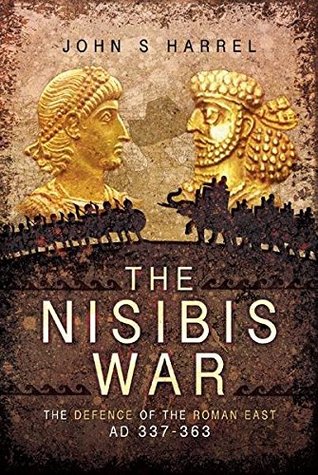The Nisibis War
 You’ve probably never heard of this war. There’s a good reason: John Harrel is the only one calling it that. This book covers what is usually considered two wars, neither of which seems to have any sort ‘official’ name. “Nisibis” was the name of a city that Rome had gotten in the previous peace deal with Persia (known as the Peace of Nisibis), and was the focus of much of the campaigning in this period, though not where the most decisive actions happened.
You’ve probably never heard of this war. There’s a good reason: John Harrel is the only one calling it that. This book covers what is usually considered two wars, neither of which seems to have any sort ‘official’ name. “Nisibis” was the name of a city that Rome had gotten in the previous peace deal with Persia (known as the Peace of Nisibis), and was the focus of much of the campaigning in this period, though not where the most decisive actions happened.
Considering that there is basically nine quiet years on the frontier between the two wars, I’m not sure considering them one war is justified. However, they are of a piece, with Shapur II campaigning to drive the Roman Empire out of Mesopotamia, so no matter how you look at it, studying them together is well justified.
This is a fairly in-depth study of the campaigning and the armies of the period, and definitely recommended for anyone interested in 4th Century military history. Given the state of knowledge of the period, I think he’s a bit too certain on some of his statements, but he does a good job of laying out his thinking for the state of the Roman army, it’s composition, and sources of replenishment. There’s a good number of maps, I found the symbology a little crude, but effective.
My main problem is the use of terminology, which kind of goes all over the place. For most Roman offices, he sticks with the Roman names, in italics as foreign words, which is fine. However, he then insists on translating comes and dux as ‘count’ and ‘duke’. That is where the English words come from, but those forms come with a lot feudal baggage that has nothing to do with the Roman offices, and they shouldn’t be translated like that. Also, oddly, he insists on giving place and unit names italics as foreign words, even though as proper nouns, that not the general practice. It makes for some highly distracted reading in places.
There is also some good discussion of Shapur II’s activities (including during the ‘lull’), and discussion of his strategic skill. Sadly, while he gives a good look at Emperor Julian (and a very good account of the entire retreat from Ctesiphon), he touches on Julian’s experience (and gives an account of his campaigns in Gaul), but doesn’t consider anything analogous to Goldworthy’s assertion from In the Name of Rome that Julian’s being unused to the scale of operations (in men and distance) was the major Roman failing in 363, though he does touch on a similar idea.

Discussion ¬